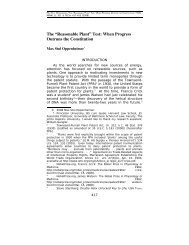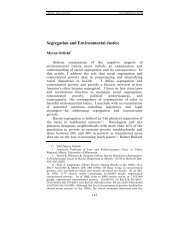An Organizational Approach to the Design of Patent Law
An Organizational Approach to the Design of Patent Law
An Organizational Approach to the Design of Patent Law
You also want an ePaper? Increase the reach of your titles
YUMPU automatically turns print PDFs into web optimized ePapers that Google loves.
6 VERTINSKY FINAL_JAD (DO NOT DELETE) 2/27/2012 2:20 PM<br />
228 MINN. J. L. SCI. & TECH. [Vol. 13:1<br />
and North are considered <strong>to</strong> be <strong>the</strong> founders <strong>of</strong> NIE, and <strong>the</strong>ir<br />
work informs our understanding <strong>of</strong> <strong>the</strong> core concepts <strong>of</strong> NIE.<br />
The focus <strong>of</strong> NIE, <strong>to</strong> <strong>the</strong> extent <strong>the</strong>re is a single focus for a<br />
loosely grouped set <strong>of</strong> analytical approaches, is on coordination<br />
<strong>of</strong> economic activities through formal and informal rules, and<br />
on <strong>the</strong> alternative governance structures within an institutional<br />
environment that are a product <strong>of</strong> political, his<strong>to</strong>rical, economic<br />
and social forces. 64 Property rights and patent rights are<br />
formal institutions designed <strong>to</strong> describe <strong>the</strong> boundaries <strong>of</strong>, and<br />
allocate control rights over, <strong>the</strong> disposition and use <strong>of</strong> resources.<br />
Formal rules interact with informal rules, such as<br />
norms and cus<strong>to</strong>ms regarding fairness and business attitudes,<br />
<strong>to</strong> create <strong>the</strong> “institutional environment,” or set <strong>of</strong> background<br />
constraints, that guide transactions. 65 North draws an analogy<br />
between <strong>the</strong> institutional environment and <strong>the</strong> rules <strong>of</strong> a game,<br />
with institutions defining and limiting <strong>the</strong> set <strong>of</strong> choices available<br />
<strong>to</strong> individuals. 66 Individuals or individual entities enter in<strong>to</strong><br />
agreements <strong>to</strong> govern <strong>the</strong>ir specific relationships in light <strong>of</strong><br />
<strong>the</strong> background rules. 67 These arrangements are <strong>of</strong>ten referred<br />
<strong>to</strong> as governance structures, and include <strong>the</strong> use <strong>of</strong> contracts<br />
and different types <strong>of</strong> public and private bureaucracy as alternative<br />
ways <strong>to</strong> organize economic activities. 68 Governance involves<br />
<strong>the</strong> interaction <strong>of</strong> public and private orderings; public<br />
ordering can be viewed as <strong>the</strong> “rules <strong>of</strong> <strong>the</strong> game,” while private<br />
ordering can be viewed as <strong>the</strong> “play <strong>of</strong> <strong>the</strong> game.” 69 Organizations<br />
can be unders<strong>to</strong>od as groups <strong>of</strong> people and <strong>the</strong> arrangements<br />
those people create <strong>to</strong> coordinate <strong>the</strong>ir collective actions,<br />
and include firms, government entities, universities, families,<br />
64. NIE provides multiple methodologies for studying economic behavior,<br />
including a combination <strong>of</strong> ma<strong>the</strong>matical modeling, case studies, econometric<br />
modeling, and experiments <strong>to</strong> test alternative <strong>the</strong>ories. See Joskow, supra note<br />
59, at xxxix-xli (exploring <strong>the</strong> methodologies <strong>of</strong> NIE). NIE encompasses diverse<br />
work on transaction costs, agency costs, property rights, incomplete contracts,<br />
social costs, collective action, and hierarchy and organization. See, e.g., Brian<br />
Dollery, New Institutional Economics and <strong>the</strong> <strong>An</strong>alysis <strong>of</strong> <strong>the</strong> Public Sec<strong>to</strong>r, 18<br />
REV. POL’Y RES. 185 passim (2001).<br />
65. See North, supra note 60.<br />
66. Id. at Part III.<br />
67. See, e.g., OLIVER E. WILLIAMSON, THE MECHANISMS OF GOVERNANCE<br />
4–5 (1996).<br />
68. See, e.g., id. at 5.<br />
69. See Oliver E. Williamson, The Lens <strong>of</strong> Contract: Private Ordering, 92<br />
AM. ECON. REV. 438, 438 (2002).






